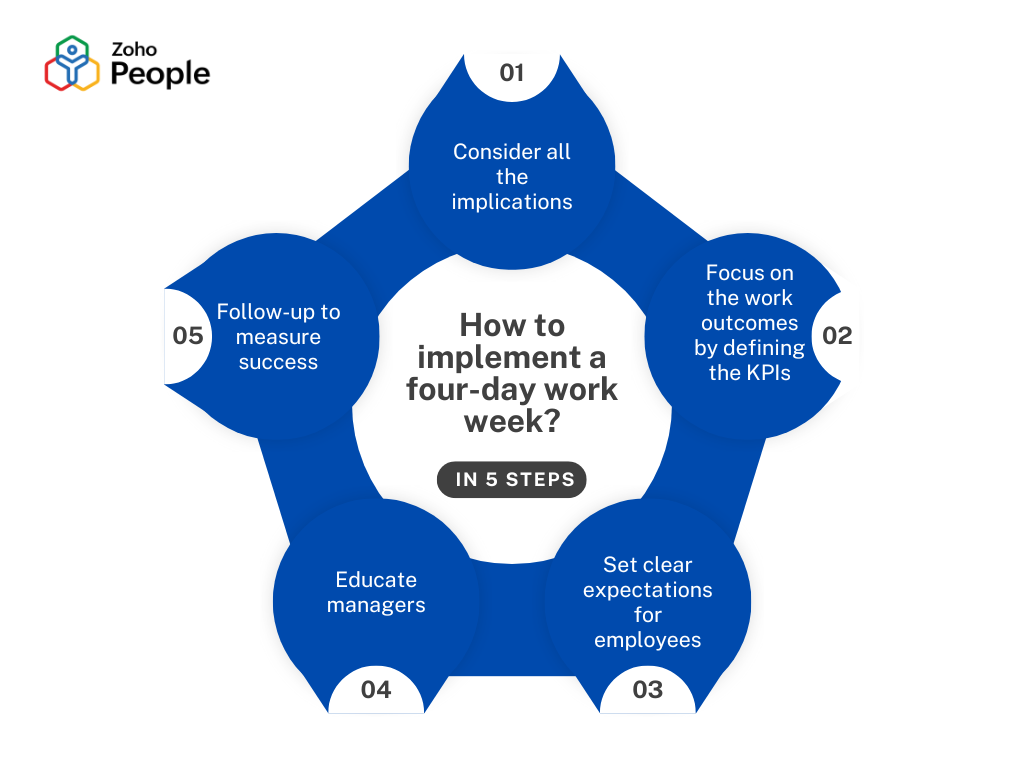- HOME
- HR insights
- Four-day work week: Understanding its basics
Four-day work week: Understanding its basics
- Last Updated : March 13, 2024
- 2.2K Views
- 6 Min Read

Flexibility has become one of the key expectations of many employees, especially those from the younger generations. One form of flexibility that seems to be very popular among both employees and organizations alike is the four-day workweek. Organizations want to see if this type of workweek can encourage greater productivity while affording the flexibility that employees value. If you're wondering if a four-day workweek is something that your organization should try, check out the basics and benefits below.
What is a four-day workweek?
A four-day work week, also known as a compressed work week, is one of the latest workplace models, where employees are asked to work four days a week instead of the traditional five or six days. Employees either work between Monday to Thursday or Tuesday to Friday. Some organizations continue to have employees work for about 8 hours a day. In this case, their total working hours would amount to 32 hours per week. Other organizations ask employees to work for 10 hours a day to compensate for the one day that gets missed. In this case, the total working hours would be 40 hours per week, similar to the five-day workweek.
What are the pros of a four-day workweek?
Here are some of the advantages that come with adopting a four-day workweek:
Better access to talent
According to a Gartner poll, about 63% of candidates say that a four-day workweek that provides the same pay as a traditional workweek would attract them to a job. By providing this benefit, you would show your organization's commitment to employee satisfaction and well-being, which could improve your employer brand and help you attract top talent.
Higher productivity
Since employees are expected to get more done in a comparatively shorter amount of time, the four-day workweek is said to help them be more focused on daily tasks and better prioritize their work items. According to a UK study, most organizations reported an increase in productivity after a six-month trial run of a four-day work week.
Happier and healthier employees
A four-day workweek has been proven to help employees reduce their stress, strike a better work-life balance, beat burnout, and improve their overall well-being. This increases the chances for better physical health, too. When employees have the best of both their work and personal lives, they tend to be much happier.
Better retention
Adopting a four-day workweek shows that you value your employees and put them and their well-being first. Along with this, higher levels of productivity and a stronger work-life balance mean employees will be more motivated to stay at your organization.
What are the cons of a four-day workweek?
Here are some of the most common disadvantages that come with adopting a four-day workweek:
Longer work days for employees
At least during the initial period, employees may find it challenging to complete all of their work items in four days. This could put extra stress and pressure on your employees, as they may feel the need to extend their working hours to get everything done.
May not be successful for all companies
A four-day workweek may not be successful for all companies. For instance, employees who are paid based on the number of hours they put in, like many blue-collar workers, may receive lower overall pay, which could cause larger issues. Similarly, companies that coordinate regularly with partners and vendors who work five days a week may find it difficult to schedule meetings and deliveries. Further, organizations with fewer employees may see a drop in productivity.
Could cause a negative impression among customers
Some companies, especially the ones in the service sector, could see a competitive disadvantage if they don't provide traditional hours. Customers may find it difficult to reach the necessary support, and their wait time may increase.
Which countries have executed the four-day workweek?
Considering the benefits of a four-day work week, companies in Germany, Japan, the Netherlands, the UK, New Zealand, Ireland, Denmark, Australia, Iceland, Norway, and the US have experimented with it. For instance, in the UK, a four-day workweek trial was run for six months from June 2022 to December 2022 with about 61 organizations. According to a related report, a follow-up after a year of the trial revealed that 31 companies of the 61 made the four-day workweek permanent. Almost all of the organizations agreed that a four-day workweek had a positive impact on them. Similarly, Germany started a trial with 45 organizations in February 2024 to see if a four-day workweek could be beneficial.
How to implement a four-day workweek?

With proper planning, you can also implement a four-day work week at your organization. Here are five steps to do it well:
1. Consider all the implications
Before implementing the four-day workweek, develop an implementation plan to ensure that all the key stakeholders are on the same page. Be sure to have a word with employees and get their buy-in by highlighting its benefits. Have a detailed discussion with project management and customer-facing teams to identify the implications and address them. Based on this, define your new work week. Remember to involve your legal team to ensure that your policy is in line with the labor laws applicable to your organization, and decide on crucial details like working hours, holidays, and time off.
2. Focus on the outcomes
With a four-day workweek, it's always good to focus on the outcomes rather than fixating on the processes. Have each of your managers define the outcomes and KPIs that they wish to see after a certain period. For instance, the desired outcome for customer support teams could be closing all the support tickets assigned to them during the defined period. Similarly, for a project management team, the desired outcome could be ensuring the quality of the project throughout the lifecycle and delivering it within its deadlines. Whatever it is for your team, define it to track productivity throughout.
3. Set clear expectations for employees
Since this concept is relatively new to your employees, it's good to help them understand what is expected from them under the new workplace model. Here are a few things that you should clarify:
Work hours: Define the number of hours your employees are expected to work. If your organization is open to affording even more flexibility, let employees manage their time and schedule. Make them aware of your expectations for their availability, too.
Communication: Let them know about the different channels of communication that you have and how soon they're expected to respond.
Performance: Set clear expectations about the desired outcomes and how often you'll have evaluations to measure their productivity and performance.
4. Educate managers
Since managers are also new to a four-day workweek, they may not know how to manage their team members. If they start micromanaging their team members to keep up with daily tasks, the whole experience can turn bitter for your employees and spoil the benefits that come with the four-day workweek. Managers can instead check in with their team members at the end of every week to go over their progress, offer feedback, and help in prioritizing their tasks. Encourage managers to be prudent about conducting meetings and have at least one no-meeting day to help employees focus on their tasks.
5. Follow-up to measure success
Have your managers conduct continuous performance reviews at least once every three months to check progress and track the set metrics outcomes. You can also encourage your employees to complete self-assessments that help them understand their progress toward key milestones and overall productivity. In addition to this, ask employees and managers for feedback on how the transition impacted them, what has worked for them so far, and what could be improved.
Wrapping up
With the four-day workweek starting to become more popular with employees and organizations, it may be beneficial to implement one for your organization. Be sure to understand its potential impact on your employees and your customers before giving it a try, as this will make for a smoother overall transition.
Also read:
 Tarika
TarikaContent Specialist at Zoho People


